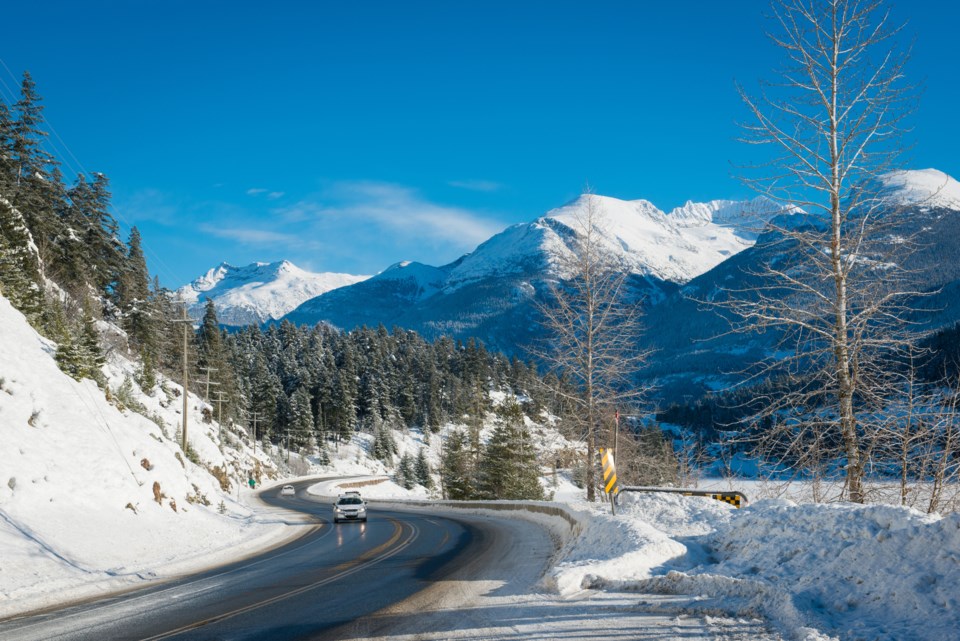Driving the Sea to Sky Highway is tricky enough when the weather is good, but throw in hazardous winter conditions like the snow forecast for later today between �鶹�����and Whistler, and it becomes even more challenging.
Prepare
Brian Hart, training manager for Young Drivers of Canada, a driving school for those new behind the wheel, said one of the keys to driving safety in the winter starts well before a driver gets behind the wheel.
Winterize your vehicle
Making sure that the vehicle is winterized is a first step.
It is the law that vehicles must have winter tires on the Sea to Sky Highway from Oct. 1 to March 31.
Hart said that even where not required, winter tires are recommended during the colder months.
"Winter tires will grip an awful lot better on the snow and the ice. Those cuts that you can see across the treads is known as siping," Hart explained. "And that really helps with the traction, plus the rubber compounds are a little softer [with winter tires], so it has a tendency to stick a little better than normal tires."
Canadian drivers should also always have a good scraper and brush to remove snow before driving.
All snow should be removed from the vehicle, to prevent snow blowing back at other drivers, or sliding down onto the driver's windshield, blocking the view.
"It's dangerous, too, because it can come off in chunks. And that could hit the person behind you causing a distraction there," he said.
Pack a safety kit
Packaging a winter safety kit in the car is also important when driving the Sea to Sky Highway.
Hart said to include the basics like water and a snack, but also blankets, gloves, a toque and the like, as it can be very uncomfortable to be stuck on the highway in winter without these things.
It is also not unheard of for drivers to be stuck for hours behind a crash on Highway 99, especially if a law enforcement investigation is underway.
"We would always recommend, too, things like carrying extra washer fluids—kitty litter is a good one if you ever get stuck," Hart said.
(Cat litter can be used in a pinch as traction for stuck tires.)
Hart says he advises new drivers to have a high-vis vest in the trunk as well, in case there is a need to get out of the vehicle.
Planning
It seems obvious, but accidents each winter show that planning isn't always done; before driving up the Sea to Sky, always check the traffic and current conditions online.
Sometimes, it just might be better to cancel plans and stay home, Hart said.
"Just take a breath and think about it before you go: Think safety. That's most important," said Hart, adding that it is easy to cave to the internal or external pressure to make a trip in bad conditions that just isn't worth the risk.
On the road
Once driving in winter conditions, crashes can often be prevented by leaving space between vehicles.
"People just don't give themselves enough space to deal with an issue," Hart said. "They drive way too close to people in front of them and that's a problem. ... We always recommend that you keep several car lengths away from people, even if you're just stopped; if nobody's behind you, don't get too close."
He added that it also makes sense not to drive directly beside someone on snowy roads.
"If you're on a multi-lane road in an area, don't drive beside the person in the next lane. If they start slip-sliding, you're in a bad spot," he said.
Hart said studies have shown crashes are reduced when vehicle lights are on, regardless of the time of day.
"We would recommend that to anybody all the time, whether the conditions are poor or not. It is just something to make the vehicle better seen."
No need for speed
And slow down to drive to the conditions, Hart said.
According to , there are about 35 deaths a year on B.C. roads due to drivers going too fast for the conditions.
"Keep it slower. People have a tendency to just keep going in those conditions, at the normal speeds they would and don't consider the fact that your traction is not as good and you're going to slip-slide," he said.
Be black ice aware
Drivers should be alert for where black ice commonly forms.
"Black ice will occur a lot on overpasses because the bridge is not insulated by the ground underneath," Hart said.
Under overpasses can also have black ice because it is in the shadow of the bridge above.
It can also form on a sunny day when snow melts and then freezes, Hart noted.
"You get a little bit of wind drifting and that nice little sneaky snow going across the road—that can easily create black ice conditions. The sun is melting that snow, as it trails across the road and the asphalt, creating that thin little layer of ice.
When you see that, obviously slow down.
If you start to skid
If you start to slide, though, the general rule of thumb for a rear-wheeled vehicle is to drive in the direction of the skid.
"If the back end starts coming out on you going one way or the other, you generally steer into the way the back end is going," he said.
"But the most important thing about trying to recover from a skid or a slide is looking where you actually want the car to go ... that's really what will help you with it. And then the hands are just going to take over pretty quick."
With front-wheel drive, the driver may want to give a little tap on the gas.
"Because it's the front wheels that are pulling the car and that little burp on the gas pedal will actually help to pull her back in line."
Find more winter driving tips from





